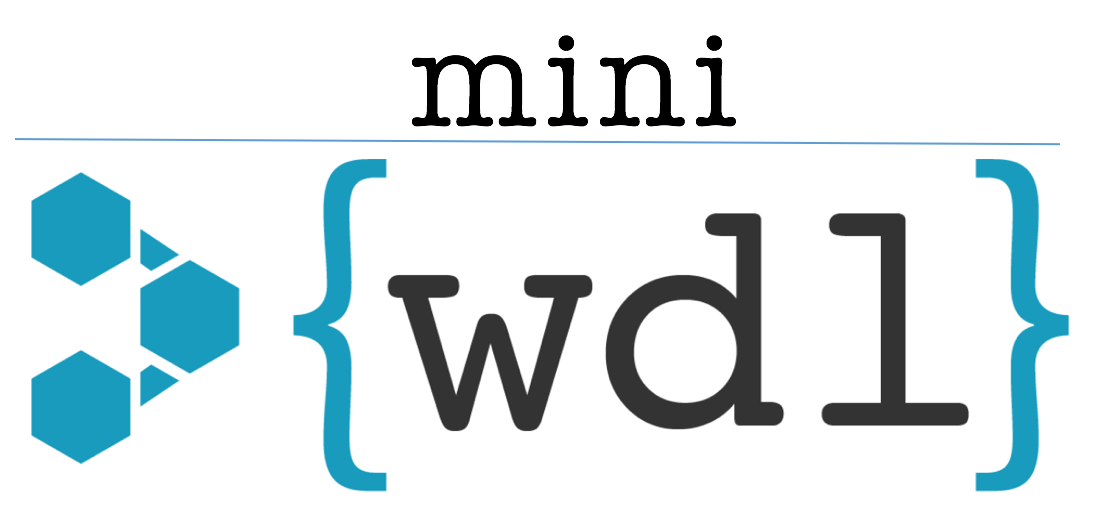Getting Started¶

miniwdl is a local runner and developer toolkit for the bioinformatics-focused Workflow Description Language (WDL). In this tutorial, we’ll install miniwdl and use its runner to assemble an Ebola virus (EBOV) genome from short sequencing reads.
TIP: If you are new to working with WDL workflow language, you may want to review the open source ‘learn-wdl’ course’ - link.
Also there is an embedded short course ‘learn-miniwdl’ which includes screencasts reviewing the tutorial on this page in more detail - link
Install miniwdl¶
Requirements:
- GNU/Linux or macOS (specific steps required)
- Python 3.6 or higher
- Docker Engine 17 or higher (if unable, see alternate container runtimes)
- Unix user must have permission to control Docker
Installation options:
- via PyPI:
pip3 install miniwdl - via conda:
conda install -c conda-forge miniwdl - see the GitHub repo README to install from source
Then open a command prompt and try,
miniwdl run_self_test
…to test the installation with a trivial built-in workflow. This should print numerous log messages, and conclude with miniwdl run_self_test OK in about 30 seconds.
Fetch viral-pipelines¶
For this exercise we’ll use the Broad Institute’s viral sequencing pipeline, which includes a small EBOV dataset for testing. Start by fetching a copy,
wget -nv -O - https://github.com/broadinstitute/viral-pipelines/archive/v2.1.0.2.tar.gz | tar zx
cd viral-pipelines-*
Run assemble_refbased workflow¶
First we can use miniwdl to preview the inputs and outputs of the reference-based assembly workflow:
$ miniwdl run pipes/WDL/workflows/assemble_refbased.wdl
missing required inputs for assemble_refbased: reads_unmapped_bams, reference_fasta
required inputs:
Array[File]+ reads_unmapped_bams
File reference_fasta
optional inputs:
String sample_name
...
outputs:
File assembly_fasta
Int assembly_length
Int assembly_length_unambiguous
Int reference_genome_length
Float assembly_mean_coverage
...
To invoke the workflow, miniwdl can accept the inputs as command-line arguments in most cases. Here we’ll start it on the test reads and EBOV reference genome included in the repository:
$ miniwdl run pipes/WDL/workflows/assemble_refbased.wdl \
reads_unmapped_bams=test/input/G5012.3.testreads.bam \
reference_fasta=test/input/ebov-makona.fasta \
sample_name=G5012.3 --verbose
The workflow should finish in just a few minutes.
- Adding
--verboseshows more status detail, including a realtime log of each task’s standard error stream (often informative for debugging). - A space may be included after a
=and before an input value, allowing shell filename autocompletion on the latter. - Array inputs can be supplied on the command-line by repeating, e.g.
array_input1=/path/to/file1 array_input1=/path/to/file2translates to{"array_input1": ["/path/to/file1", "/path/to/file2"]} - Strings with spaces can be supplied by quoting the whole pair,
"name=Wid L. Hacker" - For other cases or to separate inputs from the invocation, you can supply a Cromwell-style JSON file with
--input inputs.json.
Inspect results¶
By default, miniwdl run creates a new subdirectory of the current working directory, used for all of the workflow’s operations. The subdirectory’s name is timestamp-prefixed, so that multiple runs sort in the order they were invoked. The workflow directory can be overridden on the command line; see miniwdl run --help for details.
The standard output from miniwdl run provides the subdirectory along with JSON describing the workflow outputs, for example (abbreviated):
{
"outputs": {
"assemble_refbased.assembly_length": 18865,
"assemble_refbased.assembly_length_unambiguous": 18865,
"assemble_refbased.assembly_mean_coverage": 94.95885858958806,
"assemble_refbased.assembly_fasta": "/tmp/viral-pipelines-2.1.0.2/20200604_132146_assemble_refbased/out/assembly_fasta/G5012.3.fasta",
"assemble_refbased.reference_genome_length": 18959,
...
},
"dir": "/tmp/viral-pipelines-2.1.0.2/20200604_132146_assemble_refbased"
}
This is also stored in outputs.json in the subdirectory. For your convenience, miniwdl furthermore generates a symbolic link _LAST pointing to the timestamped subdirectory for most recent run; and an out directory tree containing symbolic links to the output files.
$ tree _LAST/out/
_LAST/out/
├── align_to_ref_merged_aligned_trimmed_only_bam
│ └── G5012.3.align_to_ref.trimmed.bam -> ../../call-merge_align_to_ref/work/G5012.3.align_to_ref.trimmed.bam
├── align_to_ref_merged_coverage_plot
│ └── G5012.3.coverage_plot.pdf -> ../../call-plot_ref_coverage/work/G5012.3.coverage_plot.pdf
├── align_to_ref_merged_coverage_tsv
│ └── G5012.3.coverage_plot.txt -> ../../call-plot_ref_coverage/work/G5012.3.coverage_plot.txt
├── align_to_ref_multiqc_report
│ └── multiqc.html -> ../../call-multiqc_align_to_ref/work/multiqc-output/multiqc.html
├── align_to_ref_per_input_aligned_flagstat
│ └── 0
│ └── G5012.3.testreads.all.bam.flagstat.txt -> ../../../call-align_to_ref-0/work/G5012.3.testreads.all.bam.flagstat.txt
├── align_to_ref_variants_vcf_gz
│ └── G5012.3.sites.vcf.gz -> ../../call-call_consensus/work/G5012.3.sites.vcf.gz
├── align_to_self_merged_aligned_only_bam
│ └── G5012.3.merge_align_to_self.bam -> ../../call-merge_align_to_self/work/G5012.3.merge_align_to_self.bam
├── align_to_self_merged_coverage_plot
│ └── G5012.3.coverage_plot.pdf -> ../../call-plot_self_coverage/work/G5012.3.coverage_plot.pdf
├── align_to_self_merged_coverage_tsv
│ └── G5012.3.coverage_plot.txt -> ../../call-plot_self_coverage/work/G5012.3.coverage_plot.txt
└── assembly_fasta
└── G5012.3.fasta -> ../../call-call_consensus/work/G5012.3.fasta
The out links are often more convenient to consume than the JSON, but they only capture outputs that are files. Individual tasks and sub-workflows run in their own nested subdirectories, each with a similar structure.
Next steps¶
The following pages document features and optimization for miniwdl run, including numerous available configuration options. Use miniwdl configure to create a configuration file with common options interactively.
To aid the workflow development cycle, miniwdl also includes a static code quality checker, miniwdl check. Lastly, installing miniwdl makes available a Python WDL package, providing programmatic access to miniwdl’s WDL parser and runtime.
The miniwdl runner schedules WDL tasks in parallel up to the CPUs & memory available on the local host; so a more-powerful host enables larger workloads. Separately-maintained extensions can distribute tasks to cloud & HPC backends:
- miniwdl-omics-run tool for the Amazon Omics workflow service
- AWS Batch
- SLURM
Links¶
- chanzuckerberg/miniwdl GitHub where issues & contributions are welcome
- openwdl/wdl GitHub for WDL spec & proposals
- OpenWDL Slack #miniwdl for discussions
- CZI Science Tech sponsors this project